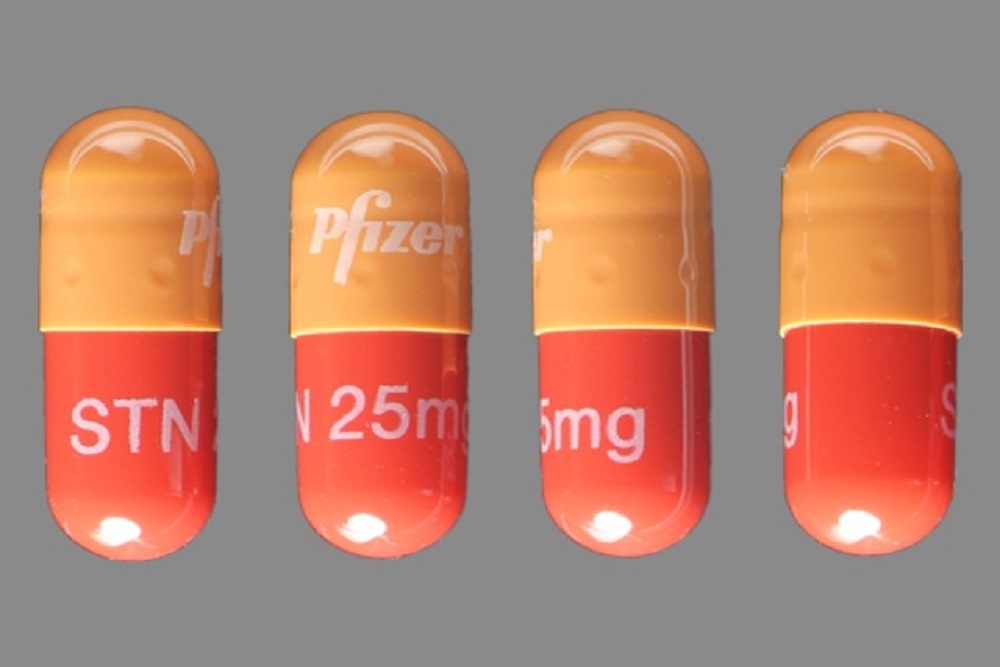Pfizer issued the following announcement on Feb. 23.
Pfizer Inc. (NYSE:PFE) announced that the Committee for Medicinal Products for Human Use (CHMP) of the European Medicines Agency (EMA) has recommended against expanding use of SUTENT® (sunitinib) to include the adjuvant treatment of adult patients at a high risk of recurrent renal cell carcinoma (RCC) following nephrectomy (surgical removal of the cancerous kidney). The CHMP’s recommendation is not binding but will now be taken into consideration by the European Commission (EC). There is currently no approved adjuvant treatment option available for patients with non-metastatic RCC at high risk for recurrence in the European Union (EU).
In the U.S., SUTENT is approved for the adjuvant treatment of adult patients at high risk of recurrent RCC following nephrectomy
“We remain confident in the potential of SUTENT for RCC patients at high risk of their cancer returning after surgery who today are restricted to a wait and see, or more accurately, a wait and worry approach,” said Mace Rothenberg, MD, chief development officer, Oncology, Pfizer Global Product Development. “We will continue to work closely with the European Medicines Agency as they complete their review and render a decision on this application.”
On November 16, 2017, the U.S. Food and Drug Administration approved an expanded indication for SUTENT as the first treatment for adult patients at high risk of recurrence following nephrectomy. The FDA expanded indication was based on results from the S-TRAC trial, a multicenter, international, randomized, double-blind, placebo-controlled Phase 3 trial of SUTENT versus placebo in 615 patients with clear cell histology and high risk of recurrence following nephrectomy. The results were published by The New England Journal of Medicine in October 2016.
Each year, approximately 338,000 new cases of kidney cancer are diagnosed worldwide, representing approximately 2-3 percent of all cancers.1,2,3 Approximately 75 percent of patients with clear cell RCC are non-metastatic, and 70-80 percent will have a nephrectomy with curative intent.4 Patients at high risk of recurrence represent approximately 10 percent of all patients with primary resected RCC and approximately 60 percent of these patients will recur and develop metastatic disease within five years.5
Pfizer is dedicated to addressing the unmet needs of patients and has been advancing the science of RCC for the last decade through research into established and novel compounds. Our near-term areas of focus include expanding access of our marketed products, exploration of biomarkers to better personalize therapy and immunotherapy combinations.
SUTENT Important Safety Information
Boxed Warning/Hepatotoxicity has been observed in clinical trials and postmarketing experience. Hepatotoxicity may be severe, and in some cases fatal. Monitor hepatic function and interrupt, reduce, or discontinue dosing as recommended. Fatal liver failure has been observed. Monitor liver function tests before initiation of treatment, during each cycle of treatment, and as clinically indicated. Interrupt SUTENT for Grade 3 or 4 drug-related hepatic adverse reactions and discontinue if there is no resolution. Do not restart SUTENT if patients subsequently experience severe changes in liver function tests or have signs and symptoms of liver failure.
Cardiovascular events, including myocardial ischemia, myocardial infarction, left ventricular ejection fraction declines to below the lower limit of normal and cardiac failure including death have occurred. Monitor patients for signs and symptoms of congestive heart failure. Discontinue SUTENT for clinical manifestations of congestive heart failure. In patients without cardiac risk factors, a baseline evaluation of ejection fraction should be considered. Baseline and periodic evaluations of left ventricular ejection fraction should also be considered while these patients are receiving SUTENT.
SUTENT can cause QT Prolongation in a dose-dependent manner, which may lead to an increased risk for ventricular arrhythmias including Torsades de Pointes, which has been seen in <0.1% of patients. Monitor patients that are at a higher risk for developing QT interval prolongation, including those with a history of QT interval prolongation, patients who are taking antiarrhythmics, or patients with relevant pre-existing cardiac disease, bradycardia, or electrolyte disturbances. Consider monitoring of electrocardiograms and electrolytes. Concomitant treatment with strong CYP3A4 inhibitors may increase sunitinib plasma concentrations and dose reduction of SUTENT should be considered.
Hypertension may occur. Monitor blood pressure and treat as needed with standard antihypertensive therapy. In cases of severe hypertension, temporary suspension of SUTENT is recommended until hypertension is controlled.
Hemorrhagic events, including tumor-related hemorrhage, and viscus perforation (both with fatal events) have occurred. These events may occur suddenly, and in the case of pulmonary tumors, may present as severe and life-threatening hemoptysis or pulmonary hemorrhage. Perform serial complete blood counts (CBCs) and physical examinations.
Cases of tumor lysis syndrome (TLS) (some fatal) have been reported. Patients generally at risk of TLS are those with high tumor burden prior to treatment. Monitor these patients closely and treat as clinically indicated.
Thrombotic microangiopathy (TMA), including thrombotic thrombocytopenic purpura and hemolytic uremic syndrome, sometimes leading to renal failure or a fatal outcome, has been reported in patients who received SUTENT as monotherapy and in combination with bevacizumab. Discontinue SUTENT in patients developing TMA. Reversal of the effects of TMA has been observed after treatment was discontinued.
Proteinuria and nephrotic syndrome have been reported. Some of these cases have resulted in renal failure and fatal outcomes. Monitor patients for the development or worsening of proteinuria. Perform baseline and periodic urinalysis during treatment, with follow-up measurement of 24-hour urine protein as clinically indicated. Interrupt treatment for 24-hour urine protein ≥3 grams. Discontinue for repeat episodes of protein ≥3 grams despite dose reductions or nephrotic syndrome.
Dermatologic toxicities: Severe cutaneous reactions have been reported, including cases of necrotizing fasciitis, erythema multiforme (EM), Stevens-Johnson syndrome (SJS), and toxic epidermal necrolysis (TEN), some of which were fatal. If signs or symptoms of EM, SJS, or TEN are present, discontinue SUTENT treatment. If a diagnosis of SJS or TEN is suspected, treatment must not be re-started.
Necrotizing fasciitis, including fatal cases, has been reported, including of the perineum and secondary to fistula formation. Discontinue SUTENT in patients who develop necrotizing fasciitis.
Thyroid dysfunction may occur. Monitor thyroid function in patients with signs and/or symptoms suggestive of thyroid dysfunction, including hypothyroidism, hyperthyroidism, and thyroiditis, and treat per standard medical practice.
Hypoglycemia may occur. SUTENT can result in symptomatic hypoglycemia, which may lead to a loss of consciousness or require hospitalization. Reductions in blood glucose levels may be worse in patients with diabetes. Check blood glucose levels regularly during and after discontinuation of treatment with SUTENT. Assess if antidiabetic drug dosage needs to be adjusted to minimize the risk of hypoglycemia.
Osteonecrosis of the jaw (ONJ) has been reported. Consider preventive dentistry prior to treatment with SUTENT. If possible, avoid invasive dental procedures, particularly in patients receiving intravenous bisphosphonate therapy.
Impaired wound healing has occurred with SUTENT. Temporary interruption of therapy with SUTENT is recommended in patients undergoing major surgical procedures. There is limited clinical experience regarding the timing of reinitiation of therapy following major surgical intervention. Therefore, the decision to resume SUTENT therapy following a major surgical intervention should be based upon clinical judgment of recovery from surgery.
Embryo fetal toxicity and reproductive potential
Females - SUTENT can cause fetal harm when administered to pregnant women. Advise pregnant women of the potential risk to a fetus. Advise females of reproductive potential to use effective contraception during treatment with SUTENT and for 4 weeks following the final dose.
Males - Based on findings in animal reproduction studies, advise male patients with female partners of reproductive potential to use effective contraception during treatment with SUTENT and for 7 weeks after the last dose.
Male and female infertility - based on findings in animals, male and female fertility may be compromised by treatment with SUTENT
Lactation: Because of the potential for serious adverse reactions in breastfed infants from SUTENT, advise a lactating woman not to breastfeed during treatment with SUTENT and for at least 4 weeks after the last dose.
Venous thromboembolic events: In patients treated with SUTENT (N=7527) for GIST, advanced RCC, adjuvant treatment of RCC and pNET, 3.5% of patients experienced a venous thromboembolic event; 2.2% Grade 3-4.
There have been (<1%) reports, some fatal, of subjects presenting with seizures and radiological evidence of reversible posterior leukoencephalopathy syndrome (RPLS). Patients with seizures and signs/symptoms consistent with RPLS, such as hypertension, headache, decreased alertness, altered mental functioning, and visual loss, including cortical blindness, should be controlled with medical management including control of hypertension. Temporary suspension of SUTENT is recommended; following resolution, treatment may be resumed at the discretion of the treating healthcare provider.
Pancreatic function: In a trial of patients receiving adjuvant treatment for RCC, 1 patient (<1%) on SUTENT and none on placebo experienced pancreatitis.
CYP3A4 inhibitors and inducers: Dose adjustments are recommended when SUTENT is administered with CYP3A4 inhibitors or inducers. During treatment with SUTENT, patients should not drink grapefruit juice, eat grapefruit, or take St. John's Wort.
Most common ARs & most common grade 3/4 ARs (adjuvant RCC): The most common ARs reported in ≥20% of patients receiving SUTENT for adjuvant treatment of RCC and more commonly than in patients given placebo (all grades, vs placebo) were mucositis/stomatitis (61% vs 15%), diarrhea (57% vs 22%), fatigue/asthenia (57% vs 34%), hand-foot syndrome (50% vs 10%), hypertension (39% vs 14%), altered taste (38% vs 6%), nausea (34% vs 15%), dyspepsia (27% vs 7%), abdominal pain (25% vs 9%), hypothyroidism/TSH increased (24% vs 4%), rash (24% vs 12%), hair color changes (22% vs 2%). The most common grade 3/4 ARs reported in ≥5% of patients receiving SUTENT for adjuvant treatment of RCC and more commonly than in patients given placebo (vs placebo) were hand-foot syndrome (16% vs <1%), fatigue/asthenia (8% vs 2%), hypertension (8% vs 1%), and mucositis/stomatitis (6% vs 0%).
Most common grade 3/4 lab abnormalities (adjuvant RCC): The most common grade 3/4 lab abnormalities (occurring in ≥ 2% of patients receiving SUTENT) included neutropenia (13%), thrombocytopenia (5%), leukopenia (3%), lymphopenia (3%), elevated alanine aminotransferase (2%), elevated aspartate aminotransferase (2%), hyperglycemia (2%), and hyperkalemia (2%).
Most common ARs & most common grade 3/4 ARs (advanced RCC): The most common ARs reported in ≥20% of patients receiving SUTENT for treatment-naïve metastatic RCC (all grades, vs IFNα) were diarrhea (66% vs 21%), fatigue (62% vs 56%), nausea (58% vs 41%), anorexia (48% vs 42%), altered taste (47% vs 15%), mucositis/stomatitis (47% vs 5%), pain in extremity/limb discomfort (40% vs 30%), vomiting (39% vs 17%), bleeding, all sites (37% vs 10%), hypertension (34% vs 4%), dyspepsia (34% vs 4%), arthralgia (30% vs 19%), abdominal pain (30% vs 12%), rash (29% vs 11%), hand-foot syndrome (29% vs 1%), back pain (28% vs 14%), cough (27% vs 14%), asthenia (26% vs 22%), dyspnea (26% vs 20%), skin discoloration/yellow skin (25% vs 0%), peripheral edema (24% vs 5%), headache (23% vs 19%), constipation (23% vs 14%), dry skin (23% vs 7%), fever (22% vs 37%), and hair color changes (20% vs <1%). The most common grade 3/4 ARs reported in ≥5% of patients with RCC receiving SUTENT (vs IFNα) were fatigue (15% vs 15%), hypertension (13% vs <1%), asthenia (11% vs 6%), diarrhea (10% vs <1%), hand-foot syndrome (8% vs 0%), dyspnea (6% vs 4%), nausea (6% vs 2%), back pain (5% vs 2%), pain in extremity/limb discomfort (5% vs 2%), vomiting (5% vs 1%), and abdominal pain (5% vs 1%).
Most common grade 3/4 lab abnormalities (advanced RCC): The most common grade 3/4 lab abnormalities (occurring in ≥5% of patients with RCC receiving SUTENT vs IFNα) included lymphocytes (18% vs 26%), lipase (18% vs 8%), neutrophils (17% vs 9%), uric acid (14% vs 8%), platelets (9% vs 1%), hemoglobin (8% vs 5%), sodium decreased (8% vs 4%), leukocytes (8% vs 2%), glucose increased (6% vs 6%), phosphorus (6% vs 6%), and amylase (6% vs 3%).
Most common ARs & most common grade 3/4 ARs (imatinib-resistant or -intolerant GIST): The most common ARs reported in ≥20% of patients with GIST and more commonly with SUTENT than placebo (all grades, vs placebo) were diarrhea (40% vs 27%), anorexia (33% vs 29%), skin discoloration (30% vs 23%), mucositis/stomatitis (29% vs 18%), asthenia (22% vs 11%), altered taste (21% vs 12%), and constipation (20% vs 14%). The most common grade 3/4 ARs reported in ≥4% of patients with GIST receiving SUTENT (vs placebo) were asthenia (5% vs 3%), hand-foot syndrome (4% vs 3%), diarrhea (4% vs 0%), and hypertension (4% vs 0%).
Most common grade 3/4 lab abnormalities (imatinib-resistant or -intolerant GIST): The most common grade 3/4 lab abnormalities (occurring in ≥5% of patients with GIST receiving SUTENT vs placebo) included lipase (10% vs 7%), neutrophils (10% vs 0%), amylase (5% vs 3%), and platelets (5% vs 0%).
Most common ARs & most common grade 3/4 ARs (advanced pNET): The most common ARs reported in ≥20% of patients with advanced pNET and more commonly with SUTENT than placebo (all grades, vs placebo) were diarrhea (59% vs 39%), stomatitis/oral syndromes (48% vs 18%), nausea (45% vs 29%), abdominal pain (39% vs 34%), vomiting (34% vs 31%), asthenia (34% vs 27%), fatigue (33% vs 27%), hair color changes (29% vs 1%), hypertension (27% vs 5%), hand-foot syndrome (23% vs 2%), bleeding events (22% vs 10%), epistaxis (21% vs 5%), and dysgeusia (21% vs 5%). The most common grade 3/4 ARs reported in ≥5% of patients with advanced pNET receiving SUTENT (vs placebo) were hypertension (10% vs 1%), hand-foot syndrome (6% vs 0%), stomatitis/oral syndromes (6% vs 0%), abdominal pain (5% vs 10%), fatigue (5% vs 9%), asthenia (5% vs 4%), and diarrhea (5% vs 2%).
The most common grade 3/4 lab abnormalities (advanced pNET) included decreased neutrophils (16% vs 0%), increased glucose (12% vs 18%), increased alkaline phosphatase (10% vs 11%), decreased phosphorus (7% vs 5%), decreased lymphocytes (7% vs 4%), increased creatinine (5% vs 5%), increased lipase (5% vs 4%), increased AST (5% vs 3%), and decreased platelets (5% vs 0%).
Please see full Prescribing Information, including BOXED WARNING and Medication Guide, for SUTENT® (sunitinib malate) at www.SUTENT.com.
About SUTENT® (sunitinib malate)
Sunitinib is a small molecule that inhibits multiple receptor tyrosine kinases, some of which are implicated in tumor growth, pathologic angiogenesis, and metastatic progression of cancer. Sunitinib was evaluated for its inhibitory activity against a variety of kinases (>80 kinases) and was identified as an inhibitor of platelet-derived growth factor receptors (PDGFRα and PDGFRβ), vascular endothelial growth factor receptors (VEGFR1, VEGFR2 and VEGFR3), stem cell factor receptor (KIT), Fms-like tyrosine kinase-3 (FLT3), colony stimulating factor receptor Type 1 (CSF-1R), and the glial cell-line derived neurotrophic factor receptor (RET).
SUTENT is indicated in the U.S. for the treatment of gastrointestinal stromal tumor (GIST) after disease progression on or intolerance to imatinib mesylate; the treatment of advanced renal cell carcinoma (RCC); the adjuvant treatment of adult patients at high risk of recurrent RCC following nephrectomy; the treatment of progressive, well-differentiated pancreatic neuroendocrine tumors (pNET) in patients with unresectable locally advanced or metastatic disease.
Original source can be found here.









 Alerts Sign-up
Alerts Sign-up